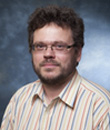
Dr. Adrian Vajiac
- Scholarly Works:
-
Digital Commons
- Education:
- University of Bucharest, Bachelor of Science
Boston University, Ph.D.
Biography
Research Interests:
Complex and Hypercomplex Analysis
Complex Analysis is a classical branch of mathematics, having its roots in late 18th and early 19th centuries, which investigates functions of one and several complex variables. It has applications in many branches of mathematics, including Number Theory and Applied Mathematics, as well as in physics, including Hydrodynamics, Thermodynamics, Electrical Engineering, and Quantum Physics.
Clifford Analysis is the study of Dirac and Dirac type operators in Analysis and Geometry, together with their applications. In 3 and 4 dimensions Clifford Analysis is referred to as Quaternionic Analysis. Furthermore, methods and tools of Clifford Analysis are extended to the field of Hypercomplex Analysis.
Algebraic Computational Methods in Geometric and Physics PDEsIn recent years, techniques from computational algebra have become important to render effective general results in the theory of Partial Differential Equations. My research is following the work of D.C. Struppa, I. Sabadini, F. Colombo, F. Sommen, etc., authors which have shown how these tools can be used to discover and identify important properties of several systems of interest, such as the Cauchy-Fueter, the Mosil-Theodorescu, the Maxwell, the Proca system, as well as the systems which naturally arise from the work of the Belgian school of Brackx, Delanghe and Sommen.
Equivariant Localization Techniques in Topological Quantum Field TheoryTopological Quantum Field Theories (TQFT) emerged in the late 1980s as part of the renewed relationship between differential geometry/topology and physics. In the 1990s, developments in TQFT gave unexpected results in differential topology and symplectic and algebraic geometry. One striking feature of physicists' approach to TQFT is the use of mathematically non-rigorous Feynman path integrals to produce new topological invariants of manifolds, which appear as the physical observables of the TQFT. My work makes use of the Mathai--Quillen formalism in the context of Equivariant Cohomology, in order to study properties of TQFTs (e.g. Donaldson--Witten and Seiberg--Witten generating functions) and relations between them.
Foundations of GeometryI am interested mostly in the Hilbertian axiomatic approach to Geometry. Far from being an expert in this field, I am studying especially the constructions of Euclidean and non-Euclidean geometries using purely geometric axioms, without using numbers, distances, and/or continuity properties.
Mathematics and Physics EducationMy interests lie in methodological aspects of introducing research ideas and modern results in Mathematics and Physics to undergraduate students and future teachers. My goal is to raise scientific awareness and interest among college and university students, and to prepare them for active research.
Recent Creative, Scholarly Work and Publications
-
"A New Type of Quaternionic Regularity", A. Vajiac, Adv. Appl. Clifford Algebras, 33:51
-
"A primer on Script Geometry", P. Cerejeiras, U.Kaehler, T. Mertens, F. Sommen, A. Vajiac, M. Vajiac, arXiv:1911.07102 [math.DG], 78 pages, 11 figures.
-
"Gleason’s problem associated to a real ternary algebra and applications", D. Alpay, A. Vajiac, M.B. Vajiac, Advances in Applied Clifford Algebras 28, p. 1-16
-
"Bernstein-type Inequalities for Bicomplex Polynomials", I. Sabadini, A. Vajiac, M.B. Vajiac, Advances in Complex Analysis and Operator Theory, Trends in Math., Birkhauser Basel, ISBN: 978-3-319-62361-0, p. 281–299.
-
"Script Geometry", P. Cerejeiras, U. Kahler, F. Sommen, A. Vajiac, Ordered Structures and Applications: Positivity VII, Trends in Mathematics, pp. 79–110, 2016, Springer International Publishing
-
"A zeta function for multicomplex algebra", A. Sebbar, D.C. Struppa, M.B. Vajiac, A. Vajiac, arXiv.1601.04785